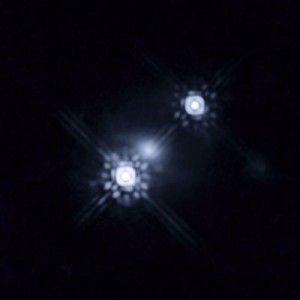 An international team of astronomers has used a new technique to study the bright disc of matter surrounding a faraway black hole. Using the NASA/ESA Hubble Space Telescope, combined with the gravitational lensing effect of stars in a distant galaxy, the team measured the disc’s size and studied the colors (and hence the temperatures) of different parts of the disc.
An international team of astronomers has used a new technique to study the bright disc of matter surrounding a faraway black hole. Using the NASA/ESA Hubble Space Telescope, combined with the gravitational lensing effect of stars in a distant galaxy, the team measured the disc’s size and studied the colors (and hence the temperatures) of different parts of the disc.
While black holes themselves are invisible, the forces they unleash cause some of the brightest phenomena in the Universe: quasars, glowing discs of matter that orbit supermassive black holes, heating up and emitting extremely bright radiation as they do so.
Until now, the minute apparent size of quasars has meant that most of our knowledge of their inner structure has been based on theoretical extrapolations, rather than direct observations. The team observed a group of distant quasars that are gravitationally lensed by the chance alignment of other galaxies in the foreground, producing several images of the quasar.
They spotted subtle differences in color between the images, and changes in color over the time the observations were carried out. Measuring the way and extent to which the dust within the galaxies blocks light (known to astronomers as the extinction law) at such distances is itself an important result in the study.
For one of the quasars they studied, though, there were clear signs that stars in the intervening galaxy were passing through the path of the light from the quasar. Just as the gravitational effect due to the whole intervening galaxy can bend and amplify the quasar’s light, so can that of the stars within the intervening galaxy subtly bend and amplify the light from different parts of the accretion disc as they pass through the path of the quasar’s light.
By recording the variation in color, the team was able to reconstruct the color profile across the accretion disc. The temperature of an accretion disc increases the closer it is to the black hole, and the colors emitted by the hot matter get bluer the hotter they are. This allowed the team to measure the diameter of the disc of hot matter, and plot how hot it is at different distances from the center.
They found that the disc is between four and eleven light-days across (approximately 100 to 300 billion kilometers).
Ref.: J. A. Muñoz, et al., A study of gravitational lens chromaticity with the Hubble Space Telescope, Astrophysical Journal, 2011; (in press) [link]